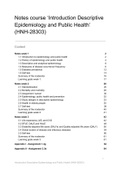Resume
Summary Notes course 'Introduction Descriptive Epidemiology and Public Health' (HNH-28303)
This is a complete summary of the course 'Introduction Descriptive Epidemiology and Public Health' (HNH-28303) of the online master Nutritional Epidemiology and Public Health.
[Montrer plus]
Publié le
8 janvier 2022
Nombre de pages
65
Écrit en
2021/2022
Type
Resume
epidemiology
public health
descriptive epidemiology
analytical epidemiology
frequency
diabetes mellitus
standardisation
mortality
morbidity
cancer
prevention
elderly people
cvd
dfle
dale
hale
dalys
le
Établissement
Wageningen University (WUR)
Cours
Online master - Nutritional Epidemiology and Public Health
Cours
HNH-28303 Introduction Descriptive Epidemiology and Public Health (HNH28303)
Tous les documents sur ce sujet (1)
Par: hermanvanderleeden • 8 mois de cela
Par: harkelien • 1 année de cela
S'abonner
€8,99
Garantie de satisfaction à 100%
Disponible immédiatement après paiement
En ligne et en PDF
Tu n'es attaché à rien




